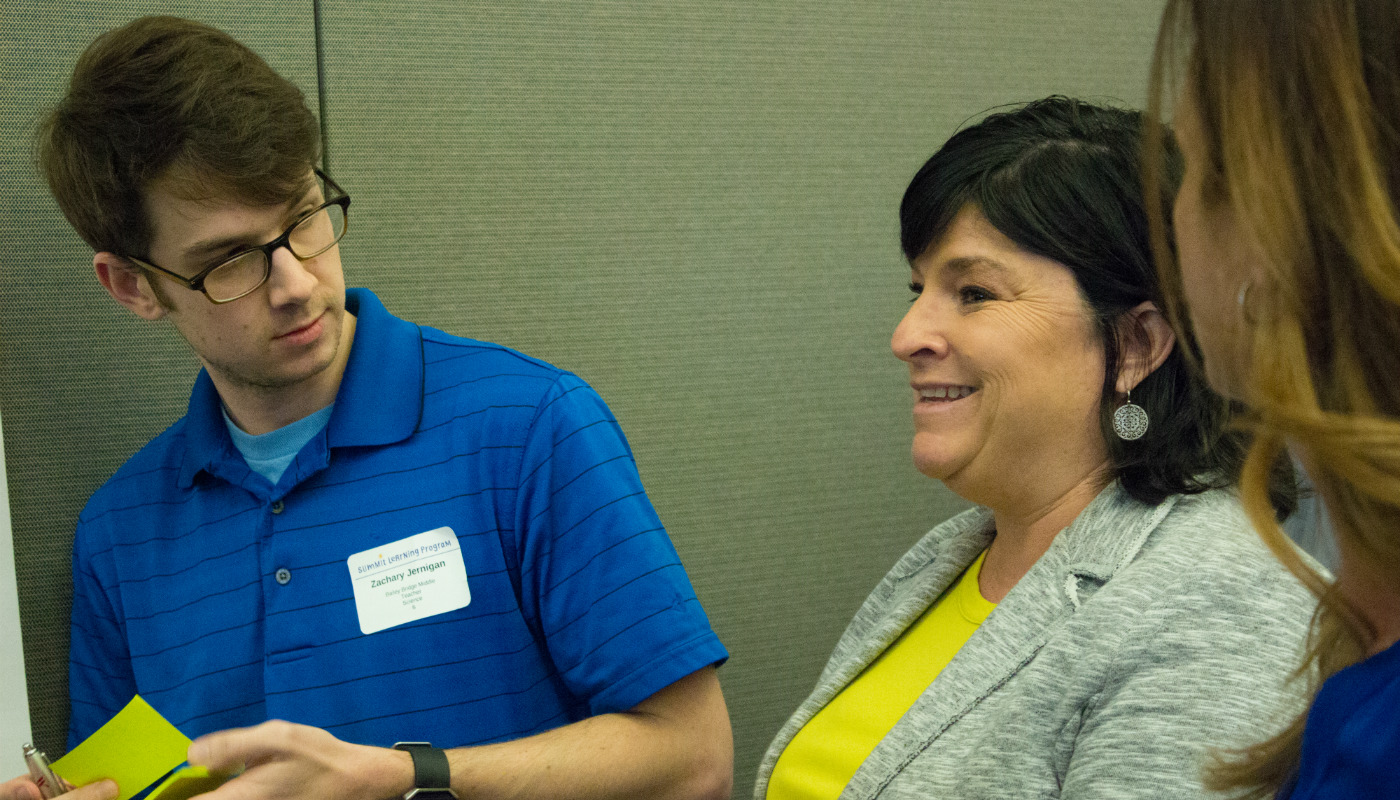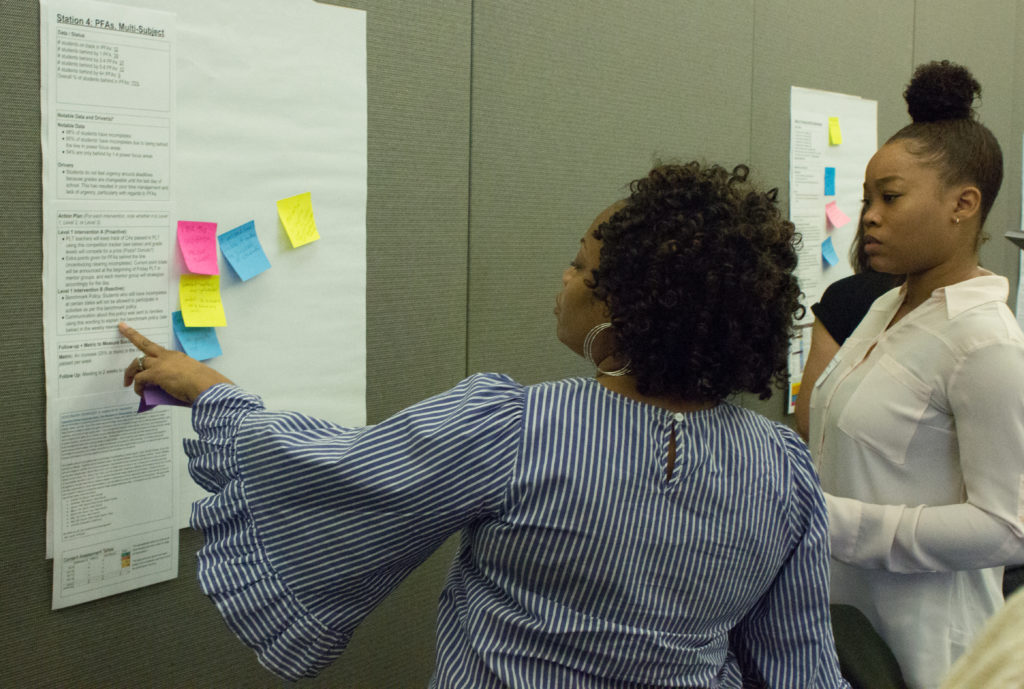
Summit Learning teachers and school leaders from the mid-Atlantic region came together in College Park, Maryland last week to identify the best ways to support their students as the school year winds down.
The two-day spring Summit Learning regional convening, one of 14 gatherings held around the country, was centered on creating effective student interventions to address all learners, built on the work that educators’ did this past fall in using data to improve instruction.
Sessions held at the College Park Marriott were organized by levels of student need: Tier 1 for most or all students, Tier 2 for groups with common needs, and Tier 3 for individual supports. Each session is led by Summit Learning mentors, who provide professional support and guidance for the more than 330 schools in the Summit Learning Program.
Summit Learning Mentor Maia Petersen emphasized that teachers should try to think of intervention ideas that don’t need hours of work, but also reminded teachers about the importance of accountability: “Think, ‘I’m creating an intervention to build my students up to where they need to be,’ not lowering the bar.”
Petersen led one of the first deep-dive sessions on creating Tier 1 interventions with each session organized around Summit Learning’s continual feedback process:
- See it — observe and analyze a product or process
- Name it — identify and name important takeaways
- Do it — work through the learned process and/or create a final product
See It: What Works in Student Interventions
As grade-level teams counted off at each table under Petersen’s guidance, they reorganized into new cross-school teams around sticky chart paper mounted around the room, each with an example of a Tier 1 intervention attached. At one station, for example, teachers assessed an action plan that included proactive and reactive interventions, including a proactive competition tracker for helping students (organized by mentor groups) increase the number of Power Focus Areas passed each week by 25%.
Teachers came ready with two sets of Post-its — one for analyzing and contributing a thought about what works in each intervention, and one for responding to another team member’s thoughts.

Name It: What Effective Interventions Have in Common
The conference room buzzed with focused discussion on identifying and naming what makes an intervention effective. With many teachers meeting for the first time, this exchange was marked by new perspectives and the occasional disagreement on why a particular intervention might work for one school but not another.
Petersen led a whole-group discussion of features that effective interventions had in common. In a matter of minutes, teachers shared a comprehensive list, from reaching grade-level team consensus on an intervention to re-teaching students self-direction and other Habits of Success.
Christina Welch, principal at Snow Hill Middle School in Maryland, believes mentoring is an essential feature of any intervention.
“Mentoring is extremely important because it helps students develop a plan for conquering the material,” Welch said. “By meeting with their mentor and planning their learning path, they are more likely to keep up with the pace of the curriculum.”
Welch also voiced that clear communication with parents about how their child is doing in class is an essential component of any intervention plan. Parents are key stakeholders in their child’s education and can serve as an at-home partner in providing their student with necessary support.
Do It: Devise a Plan for Your School
Before Petersen set teams free to create their own final product — a data-based intervention plan that would be shared later that day with their school leaders — she reiterated the four aspects that every intervention should follow:
- Directly addresses data or drivers and includes a metric to evaluate success;
- Is proactive and reactive;
- Is specific; and
- Is practical and predominantly takes place during the school day.
Then, teachers rolled up their sleeves and got started on creating their own whole-grade intervention plans. Table by table, teams created lists of data-based and effective strategies they could use in their classrooms by next week. As teachers shared ideas, they also prompted one another to think of realistic and effective ways to measure student success.
Zachary Jernigan, a 6th-grade science teacher attending the convening with two of his colleagues from Bailey Bridge Middle School in Virginia, said that his team identified their main concern as students not passing Content Assessments.
“The biggest takeaway I had from the Level 1 intervention session was the importance of being proactive,” Jernigan said. “Many of the Level 1 supports that I have been providing in Project Time and Personalized Learning Time are reactive and based on issues that I see come up. Taking the time to think about what I could do to help my students before any particular issues arise will hopefully make those classes run smoother.”
Leaving with an Actionable Plan for Student Interventions
By the end of the session, most teams had an actionable intervention plan in place. They expanded on these plans throughout the first day as they attended sessions focused on creating interventions at the group level and then for the individual.
Like students, professional adults can use a scaffolded approach like See It, Name It, and Do It to learn a new skill or concept, create a final product, and provide and receive feedback on their work. And creating a final product isn’t complete without a final round of feedback. Teams shared their plans with school leaders in time for a closing group discussion and share-out at the end of the convening.
“Being at the convening made the team realize that everyone, from any state or year of implementation, is on the same Summit journey of keeping students on track but also guiding them to be self-motivated and independent,” said Colin Innes, assistant principal at Bailey Bridge Middle School.

